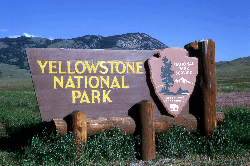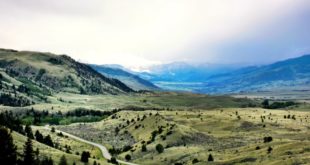As you’ll recall, Sen. Tom Coburn (R-Oklahoma) pushed legislation supported by the National Rifle Association to allow state law to trump federal guidelines regarding gun restrictions in National Parks. The legislation was attached to an unrelated credit-card bill and signed into law by President Barrack Obama. Those provisions are slated to go into effect Feb. 22.
There’s some debate as to what the effect will be in Yellowstone: Most of the Park lies within Wyoming state limits, and Wyoming law is pretty clear about what constitutes concealed-carry reciprocity. National Park Service officials said they would be formulating policies based on state law, but we’re two weeks from the law taking effect and there’s been no posted changes to firearm possession in Yellowstone National Park.
What we fear will happen: a lack of clear leadership from the NPS combined with a general misunderstanding of what the law actually entails will lead to conflicts between citizens and Park Rangers, each believing they are on the right side of the law. In any case, watch for gun rules to be a topic of discussion at the beginning of the Summer 2010 season; in theory the law would apply to those entering the Park during the current winter season, but there’s just no practical reason for a gunowner to be toting while on a snowmobile, and we think the vast majority of lawful gun owners are smart enough to see this.
Here’s the press release from the Coalition of National Park Service Retirees:
TUCSON, AZ.//February 9, 2010//Assault rifles on Mather Point overlooking the Grand Canyon? Handguns on the Filene Center concert lawn at Wolf Trap in the Washington, D.C. suburbs? Shotguns at Lamar River Valley in the backcountry at Yellowstone National Park, the world’s first national park?
These are just some of the things that Americans can reasonably expect to see in national parks across the U.S. as of February 22, 2010, when a dangerous new gun law will go into effect in our nation’s national park areas. To mark this unfortunate development, the Coalition of National Park Service Retirees (CNPSR) is highlighting what visitors may soon experience in 11 representative national parks.
An amendment to the Credit Cardholders’ Bill of Rights Act of 2009, authored by Senator Tom Coburn (R-OK), and promoted by the NRA, passed by the Congress and signed into law by the President on May 22 of last year, permits park visitors to possess firearms in national park areas consistent with the laws of the state in which the area is located.
This is a significant departure from long-established, common-sense gun regulations that allowed visitors to possess guns in parks only if they were stowed out of reach and unloaded.
Doug Morris, a member of the CNPSR Executive Council and a former law enforcement ranger and park superintendent in the NPS for many years, said: “We believe that the public should be aware of the consequences of Coburn’s amendment. While federal law prohibits the carrying of guns in any federal building where federal employees work on a regular basis, in many states there are few, if any, other prohibitions.”
While scores of national parks will be impacted to one extent or another, CNPSR highlighted the following 11 parks to show the range of likely harms:
Yellowstone National Park (WY, MT, ID): In the world’s first national park – Yellowstone, while watching Old Faithful erupt you could be in the company of other park visitors wearing holsters and hand guns. In the evening campfire circle, you may sit next to someone who can legally carry a shotgun or rifle to that special place. Anyone hiking in the backcountry can openly carry guns, increasing the risk to other hikers and park wildlife.
Wolf Trap National Park for the Performing Arts (VA): Virginia’s gun laws are very permissive. The grounds of Wolf Trap, including the “lawn seating area,” will be open to people carrying firearms.
Grand Canyon National Park (AZ): Arizona’s gun laws are very permissive and while standing on Mather Point, enjoying the breathtaking view of the canyon, you could see another visitor with an assault rifle slung on his shoulder. At your campsite in the park’s campground, you could see guns prominently displayed in the campsite next to you.
Mesa Verde National Park (CO): Colorado law is very permissive about open carry of firearms except in some cities. During your visit to Cliff Palace, you could be listening to the ranger’s interpretive discussion while standing next to someone with a handgun and holster prominently displayed.Gettysburg National Military Battlefield (PA): Pennsylvania is also a very permissive state relative to gun laws. During your tour of the battlefield, you could encounter other visitors legally carrying rifles – and not the historic kind.
Carlsbad Caverns National Park (NM): At the evening bat flight program and even on the cave tours, you could be joined by others openly carrying firearms. As you wander through the park’s restaurant and gift store, looking for a bite to eat or a souvenir to buy, other visitors might be seen legally carrying firearms.
Everglades National Park (FL): Florida’s gun laws are more restrictive, so you are not likely to encounter others openly carrying guns while walking on the Anhinga Trail as you enjoy some of the most spectacular wildlife and bird sighting anywhere.
Statue of Liberty National Monument (NY): New York’s gun laws are very restrictive, and visitors to the Statue are protected by laws prohibiting the open carrying of firearms.
Great Smoky Mountains National Park (TN and NC): This park is an example of one of the problems visitors will face with the new law. In North Carolina, there are few gun restrictions and visitors could be seen openly carrying guns. However, if you happen to be a gun-carrying visitor, you will need a “carry permit” when you cross into the part of the park located in Tennessee.
Mount Rainier National Park (WA): While hiking the famous “Wonderland Trail” you could encounter other hikers openly carrying handguns, rifles or shotguns.
Denali National Park and Preserve (AK): While riding on an NPS-licensed bus operated by the park concessioner on a day-long trip on the “park road” (the only way to get into the heart of the park other than to hike) you could be sitting next to someone with a handgun in a holster.
Bill Wade, chair of CNPSR’s Executive Council and former superintendent of Shenandoah National Park said, “This is a sad chapter in the history of America’s premier system of heritage areas. On the heels of the Ken Burns documentary about the importance of national parks to America and after a year of increased visitation to parks despite a poor economy, this law will have a chilling effect on how visitors behave in national parks. A feeling of safety and security will be replaced by wariness and suspicion. This diminishes some of the “specialness and reverence” our citizens have long accorded to their national parks.”
While many states, and therefore the national park areas in them, will soon allow individuals to openly carry firearms, most states are much more restrictive about concealed-carry, and most require a permit to do so. Visitors with a permit from one state may or may not be able to carry a concealed gun into a national park in another state, depending on reciprocity agreements. Similarly, visitors who have “long guns” in vehicle racks traveling from a park in one state to a park in another state will have to understand the differing state requirements.
Members of CNPSR strongly opposed this new law for several reasons:
1) More guns in national parks increase the likelihood of shooting at wildlife and some historic resources, such as prehistoric petroglyphs.
2) More guns in parks increases the risk to rangers.
3) More guns in parks increases the risk to visitors in places like campgrounds where disagreements, often fueled by alcohol, sometimes occur.
4) National parks have always been hospitable to visitors from around the world and are seen as “sanctuaries” where people could get away from the routines, threats and risks they face in their daily lives. But more guns will change those perceptions.
5) Until now, one regulation pertaining to firearms applied to all 392 areas in the National Park System. But now each of those areas will be subject to the laws of the state in which it lies. This is likely to lead to significant confusion by visitors traveling though parks in a number of states.
6) Federal buildings in parks will now have to be signed to prohibit firearms and conceivably security devices will need to be used.
We’ve also set up a free Twitter account so you can receive updates on the device of your choice.
 Yellowstone Insider Your Complete Guide to America's First National Park
Yellowstone Insider Your Complete Guide to America's First National Park





